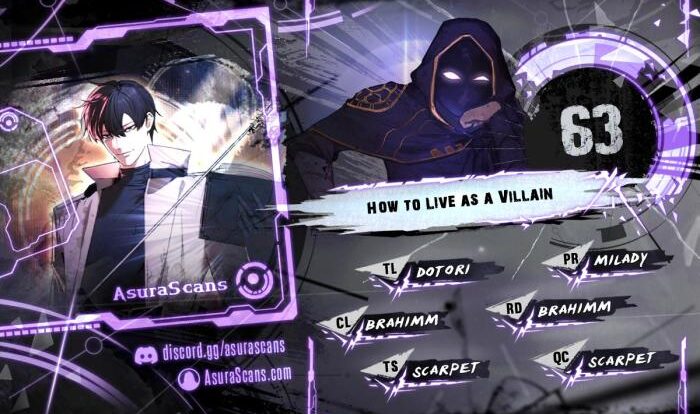
How to live as a villain ch 94 – Welcome to “How to Live as a Villain” Chapter 94! This chapter delves into the complex world of villains, exploring their motivations, plans, and the conflicts that arise from their actions.
Villains are not just evil for the sake of being evil. They have their own reasons, their own goals, and their own ways of achieving them. In this chapter, we’ll take a closer look at what drives villains and how their schemes unfold.
Character Development and Motivations
In the realm of storytelling, villains often play a crucial role in shaping the narrative and testing the boundaries of morality. Their actions and motivations can be complex and multifaceted, driving them to challenge the established order and pursue their own twisted agendas.
Unlike traditional heroic characters who are driven by altruism and a desire to protect the innocent, villains often have their own set of motivations that stem from personal experiences, trauma, or a deep-seated belief system. These motivations shape their decision-making and interactions with others, making them both compelling and relatable.
Backstory and Trauma
The backstories of villains can provide valuable insights into their motivations. Traumatic events, such as childhood abuse, loss of loved ones, or social rejection, can leave deep emotional scars that drive them towards a path of darkness. By exploring these formative experiences, we can better understand the psychological complexities that fuel their actions.
- The Joker, a notorious Batman villain, was driven by a desire for chaos and anarchy after witnessing the murder of his wife and unborn child.
- Magneto, from the X-Men franchise, seeks to protect mutants from human persecution, driven by his own experiences of discrimination and prejudice.
Moral Dilemmas
Villains often face moral dilemmas that test their beliefs and values. They may be torn between their desire for power and their conscience, or struggle with the consequences of their actions. These moral conflicts can lead to complex character development and create a sense of ambiguity in the narrative.
- Thanos, from the Marvel Cinematic Universe, believes that eliminating half of the universe’s population is necessary to prevent overpopulation and suffering.
- Walter White, from Breaking Bad, grapples with the moral implications of his drug-dealing activities as he tries to provide for his family.
Twisted Beliefs
Some villains are driven by twisted beliefs or ideologies that justify their actions. They may believe that they are superior to others, that violence is necessary to achieve their goals, or that the ends justify the means. These beliefs can lead them to commit heinous acts without remorse.
- The Joker believes that the world is inherently chaotic and that his actions are simply a reflection of that chaos.
- The White Walkers from Game of Thrones are driven by a desire to destroy all living beings, believing that they are the rightful rulers of the world.
Villainous Schemes and Plans: How To Live As A Villain Ch 94

The enigmatic villain, Damien Shadowbane, has meticulously crafted a malevolent master plan that threatens to plunge the realm into an abyss of despair. His ultimate goal is to seize control of the ancient artifact known as the Orb of Erebos, a relic of unimaginable power that could grant him dominion over the very fabric of existence.
Damien’s intricate scheme unfolds in a series of calculated steps. First, he infiltrates the royal court, using his cunning and charisma to sow discord and distrust among the nobles. By pitting them against each other, he weakens the kingdom from within, making it vulnerable to his eventual assault.
Acquisition of the Orb
As the kingdom teeters on the brink of chaos, Damien sets his sights on the Orb of Erebos, hidden deep within the ancient ruins of Eldoria. With the help of a treacherous band of mercenaries, he embarks on a perilous quest to retrieve the artifact.
Their journey is fraught with danger, but Damien’s determination remains unwavering.
Corrupting the Orb
Once in possession of the Orb, Damien unleashes his true malevolence. Using dark rituals and forbidden knowledge, he corrupts the artifact, turning its immense power to his own nefarious ends. As the Orb’s corruption spreads, it taints the land, poisoning the minds and souls of its inhabitants.
Reign of Terror
With the corrupted Orb in his grasp, Damien unleashes a reign of terror upon the realm. He commands armies of undead, summoning forth horrors from the depths of the abyss. Cities are razed, and innocent lives are extinguished as Damien’s insatiable thirst for power knows no bounds.
Conflict and Confrontations

The primary conflict in this chapter revolves around the escalating tensions between the villain, Viktor, and the protagonist, Anya. Viktor, driven by his desire for revenge, relentlessly pursues Anya, determined to make her pay for the perceived wrong she has done him.Viktor’s
strategies involve using his vast resources and cunning to outmaneuver Anya. He employs a team of loyal followers to carry out his orders, infiltrates her organization, and manipulates the media to turn public opinion against her. Anya, on the other hand, relies on her intelligence, agility, and a small group of trusted allies to outsmart Viktor and thwart his plans.The
How to live as a villain ch 94. Ever since I was introduced to this, I am completely hooked. The storytelling, the characters, the action – everything is on point. I’m already on chapter 94 and I can’t wait to see what happens next.
Check out how to live as a villain ch 94 and you’ll know what I mean. It’s a great read and I highly recommend it.
consequences of their actions have been far-reaching. Viktor’s relentless pursuit has forced Anya to confront her own vulnerabilities and question her beliefs. The conflict has also strained her relationships with her loved ones, who have become pawns in Viktor’s game.
Emotional and Physical Toll
The conflict has taken a heavy emotional and physical toll on both Viktor and Anya. Viktor’s obsession with revenge has consumed him, driving him to the brink of madness. Anya, once a confident and capable leader, is now haunted by the fear of what Viktor might do to her and those she cares about.
If you’re looking for a good read, check out how to live as a villain ch 94 . It’s a great story about a guy who’s trying to figure out how to be a villain. He’s not sure if he wants to be a good villain or a bad villain, but he’s determined to be the best villain he can be.
If you’re interested in how to live as a villain ch 94, I highly recommend checking it out.
The constant threat of danger has left both characters physically and emotionally exhausted, pushing them to their limits.
Villainy in a Complex World
In the tapestry of human existence, the threads of morality and ethics intertwine with the actions of villains, creating a complex and often unsettling spectacle. As villains navigate the labyrinthine corridors of society, their deeds ripple through the fabric of the world, leaving an indelible mark on the lives of others and the landscape they inhabit.
The motivations and actions of villains are often born out of a twisted sense of justice or a misguided desire for power. They may seek to right perceived wrongs or reshape the world according to their own distorted vision. However, their methods are often ruthless and self-serving, disregarding the well-being of others and trampling upon the principles that hold society together.
The Impact on Society, How to live as a villain ch 94
The impact of a villain’s actions can be far-reaching, extending beyond their immediate victims to the broader community and even the world at large. Their schemes may disrupt the social order, undermine trust, and sow discord among people. By challenging the established norms and values, villains can erode the very foundations of society, leaving it vulnerable to chaos and instability.
Perspectives on Villainy
The behavior of villains elicits a wide range of reactions from different characters within the story. Some may view them as monsters, devoid of any redeeming qualities, while others may harbor a grudging respect for their cunning or determination. The perspectives of heroes, anti-heroes, and ordinary citizens alike shape the narrative, providing a multifaceted exploration of the nature of villainy.
The Villain’s Redemption or Downfall
The villain’s fate is a pivotal aspect that can shape the narrative’s conclusion and the audience’s perception of the story. Redemption and downfall are two distinct paths that a villain can embark on, each with its own set of consequences and implications.
In chapter 94 of the web novel, “How to Live as a Villain,” the protagonist’s journey takes an unexpected turn as they encounter a formidable adversary. The chapter delves into the complexities of morality and the struggle between good and evil.
As the protagonist grapples with their newfound powers, they must confront their own inner demons and make choices that will shape their destiny. For those eager to continue the adventure, the full chapter can be found here .
Factors Leading to Redemption
- Epiphany or Catalyst:A profound realization or life-altering event can trigger a shift in the villain’s perspective, leading them to question their actions and motivations.
- Influence of Others:Interactions with empathetic characters, such as the protagonist or a mentor, can soften the villain’s heart and instill a sense of empathy and compassion.
- Guilt or Remorse:The weight of their actions may eventually overwhelm the villain, causing them to experience guilt and remorse, driving them to seek redemption.
Consequences of Redemption
- Second Chance:Redemption offers the villain a chance to atone for their past and forge a new path, potentially finding acceptance and redemption.
- Story Arc Completion:The villain’s redemption can provide a satisfying resolution to their character arc, allowing the audience to witness their transformation and growth.
- Theme of Forgiveness:Redemption can explore themes of forgiveness, mercy, and the capacity for change, adding depth and complexity to the narrative.
Factors Leading to Downfall
- Unredeemable Acts:The villain may have committed atrocities that are too heinous to be forgiven or atoned for, leading to their inevitable downfall.
- Pride or Arrogance:Hubris and an unwillingness to change can prevent the villain from seeing the error of their ways, resulting in their downfall.
- External Forces:Circumstances beyond the villain’s control, such as the actions of the protagonist or unforeseen events, can contribute to their defeat.
Consequences of Downfall
- Justice Served:The villain’s downfall can bring about a sense of justice and closure, satisfying the audience’s desire for retribution.
- Narrative Catharsis:The villain’s defeat can provide a cathartic release for the audience, who have witnessed their destructive actions throughout the story.
- Moral Lesson:The villain’s downfall can serve as a cautionary tale, illustrating the consequences of evil and the importance of choosing the path of righteousness.
Conclusion

In “How to Live as a Villain” Chapter 94, we’ve explored the intricate world of villains, their motivations, and the conflicts that arise from their actions. We’ve seen how villains can be complex and sympathetic characters, and how their schemes can have far-reaching consequences.
As we continue to follow the story, we’ll see how these villains evolve and how their actions shape the world around them. Stay tuned for more thrilling twists and turns in “How to Live as a Villain”!
Expert Answers
What is the main conflict in “How to Live as a Villain” Chapter 94?
The main conflict in Chapter 94 is between the villain, Dr. Evil, and the protagonist, Agent Good. Dr. Evil is trying to take over the world, while Agent Good is trying to stop him.
What are Dr. Evil’s motivations?
Dr. Evil is motivated by a desire for power and control. He believes that he is the only one who can save the world from chaos, and he is willing to do whatever it takes to achieve his goals.
What are Agent Good’s motivations?
Agent Good is motivated by a desire to protect the world from evil. He believes that Dr. Evil is a threat to humanity, and he is determined to stop him.





